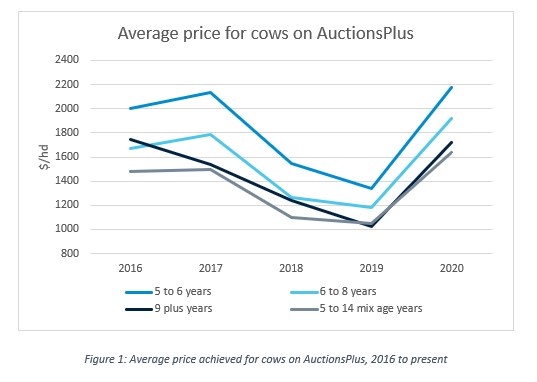The highly anticipated herd rebuild has been delayed until the end of 2020, according to Meat & Livestock Australia, as the number of females being slaughtered remains high. In spite of these recent projections, prices continue to hold as a favourable Spring is round the corner for many.
Across the board, 2020 has seen a resurgence of strong commodity prices across the livestock sector with widespread rain resulting in strong re-stocker demand. A sheer lack of supply due to relentless drought and elevated kill rates has ultimately driven prices to record highs. Traditionally, the older cow is an article not a sought-after. For breeders and restockers, the longevity and return available for a young breeding article is far more attractive. However the reduced national herd has seen buyers reconsider older cows as an alternative due to the higher commodity prices and surging demand for younger breeding articles. The increase in demand for older breeders has seen a $693/hd increase achieved across the category from 2019 to 2020.
The AuctionsPlus Market Insights team (AMI) has investigated data from 2016 to present, identifying selling trends of older cows ( 9 plus years) online and ultimately identifying periods when the price difference between older and younger cows has been reduced. This will seek to identify trends and showcase potential opportunities to gain a premium for older stock dependent on the conditions of the season.
As shown below in figure 1, 2016 was the last time older cows achieved strong prices, compared to younger females. Following tough seasons in 2014 and 2015, producers looked to restock after Autumn rain in 2016, with this heightened demand resulting in strong prices. Compared to 2020, the conditions are similar; significant widespread rainfall across the Eastern Seaboard throughout the first few months of the year has resulted in an increase in demand for breeding cattle as producers look to restock following years of drought and heavy de-stocking.

The price gap between younger cows (5 – 6 years of age) and older cows (9 + years of age) was in 2016 at its smallest difference of 13%. In 2017 and 2018 the gap widened to 28% as older cows became less favorable in comparison to their younger counterparts. So far, in 2020 this price gap has reduced to 21% as the national shortage of females is forcing restockers to look to older articles .

Shaun McHugh from Carter Lindsay & Weber, Dubbo, NSW, has recently been purchasing older lines of cows for clients looking to restock following the turn in season for the area. “National cow numbers have dropped dramatically, as a result the purchasing of older cows is helping clients who are looking to restock”.
In 2020, 78% of the older cow offering have been PTIC or Station Mated, providing a 2 for 1 article to buyers. The average price for joined cows aged 9 plus is $1,720/hd, compared to $1,027/hd at this time in 2019. For the clients of Carter Lindsay & Webber “older articles are providing the opportunity to grow out a calf before selling the cow on, the current strength of the cow kill job has increased confidence in this option”.
Purchasing a 2 in 1 or 3 in 1 article while grid prices for older females are favourable is a common approach for quick turnover and aids in buyer confidence.
As the national cattle herd is not expected to expand until later in the year, will the upward price trajectory of older cows to continue? We expect the turn off to extend into cows and calves as we move into Spring. Just how far will this increase go? Will the price gap between older and younger breeder articles drop as low 2016?
Lorem Ipsum is simply dummy text of the printing and typesetting industry. Lorem Ipsum has been the industry's standard dummy text ever since the 1500s
Subscribe to our weekly newsletter and monthly cattle, sheep, and machinery round-ups.